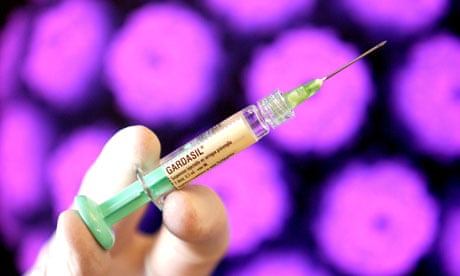The first evidence has emerged that nationwide vaccination programmes for young women against HPV, the virus that triggers cervical cancer, are likely to cut the numbers who get the disease.
A study in Australia, one of the first countries to introduce the vaccination, has shown a drop in high-grade cervical abnormalities – changes to the cells in the neck of the womb that can be the precursor to cancer.
Australia introduced nationwide HPV (human papilloma virus) vaccination for women aged 12 to 26 from 2007.
While it will take many years to find out whether vaccination programmes definitely reduce the numbers of cervical cancers in the population, Australian scientists were able to analyse the results from their screening programme to find out whether there has been any drop in the number of young women with abnormal cell changes that are the precursor of cancer.
Publishing in the Lancet medical journal, they report that the proportion of girls aged 17 and younger with high-grade abnormalities fell by almost half, from 0.80% to 0.42%.
But there was no drop in the numbers of women with cervical abnormalities who were older than 17. This is unsurprising since the vaccine is known to be most effective if given to girls before they become sexually active.
That finding, say the authors, "reinforces the appropriateness of the targeting of prophylactic HPV vaccines to pre-adolescent girls".
The findings were greeted with international interest.
"The not-so-cautious optimist in us wants to hail this early finding as true evidence of vaccine effect," write Dr Mona Saraiya and Dr Susan Hariri of the Centres for Disease Control and Prevention in Atlanta, US, in a linked commentary for the journal.
But they said they wanted to know more about the vaccine status of the individuals (each woman is supposed to have three shots) and wanted more work to establish whether the reductions in potential cancers were really a result of vaccination or some other cause.
Michael Quinn, professor of gynaecology and gynaecologic oncology at the University of Melbourne, said: "The study is the first anywhere in the world to show falling rates of high-grade change in very young women.
"Although this is likely to be due to the effects of the vaccination programme, further analysis of information linking women's smear history to their vaccination history will be needed to prove that the fall is entirely due to vaccination rather than other factors."
Public health experts say that women should not assume they are not vulnerable to the disease after vaccination and should still go for regular screening checks.
The UK introduced its own cervical cancer vaccination programme in September 2008, offering the jab in school to 12- and 13-year-old girls, with catch-up programmes for those up to 18.
The cost was expected to be £100m a year. Of the two available vaccines, the UK decided to buy Cervarix, manufactured by the British company GlaxoSmithKline, even though it does not offer the additional protection against genital warts of the alternative, Gardasil.
In spite of worries that parents would refuse to have their daughters vaccinated against what is essentially a sexually-transmitted virus, the take-up has been good, according to figures from the Department of Health.
In the school year 2009/10, more than three-quarters of 12- to 13-year-olds were given all three doses of the vaccine.

Comments (…)
Sign in or create your Guardian account to join the discussion